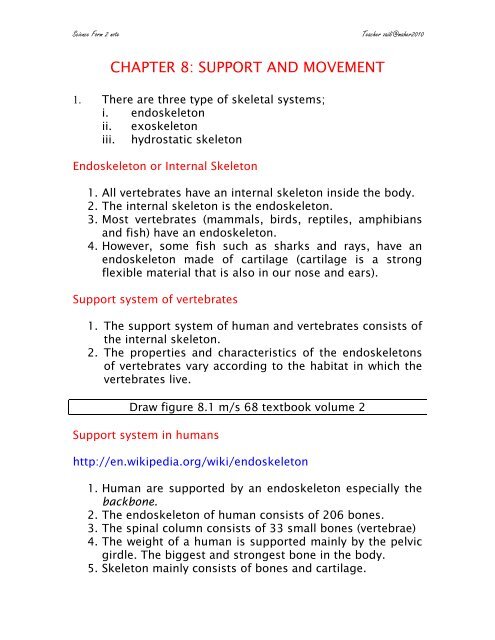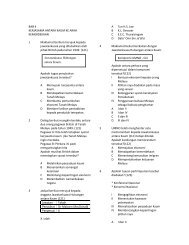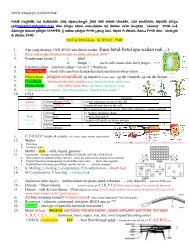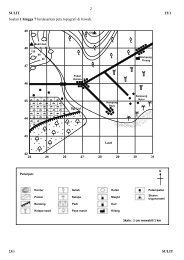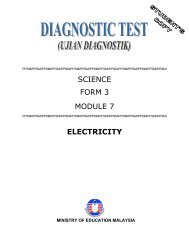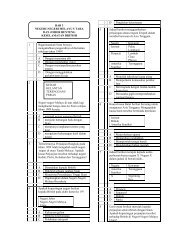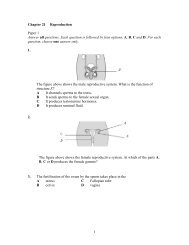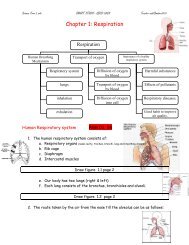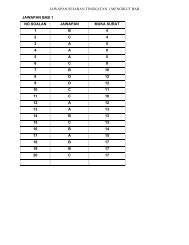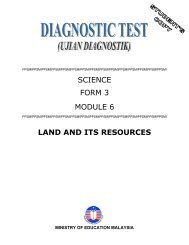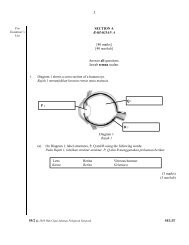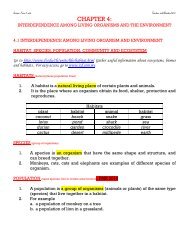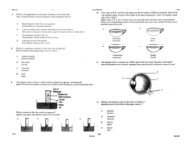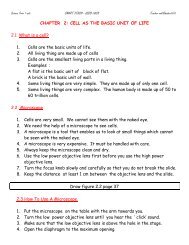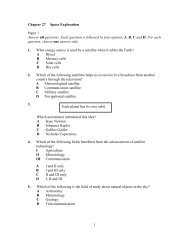CHAPTER 8: SUPPORT AND MOVEMENT
CHAPTER 8: SUPPORT AND MOVEMENT
CHAPTER 8: SUPPORT AND MOVEMENT
Create successful ePaper yourself
Turn your PDF publications into a flip-book with our unique Google optimized e-Paper software.
Science Form 2 note Teacher zaidi@maher2010<br />
<strong>CHAPTER</strong> 8: <strong>SUPPORT</strong> <strong>AND</strong> <strong>MOVEMENT</strong><br />
1. There are three type of skeletal systems;<br />
i. endoskeleton<br />
ii. exoskeleton<br />
iii. hydrostatic skeleton<br />
Endoskeleton or Internal Skeleton<br />
1. All vertebrates have an internal skeleton inside the body.<br />
2. The internal skeleton is the endoskeleton.<br />
3. Most vertebrates (mammals, birds, reptiles, amphibians<br />
and fish) have an endoskeleton.<br />
4. However, some fish such as sharks and rays, have an<br />
endoskeleton made of cartilage (cartilage is a strong<br />
flexible material that is also in our nose and ears).<br />
Support system of vertebrates<br />
1. The support system of human and vertebrates consists of<br />
the internal skeleton.<br />
2. The properties and characteristics of the endoskeletons<br />
of vertebrates vary according to the habitat in which the<br />
vertebrates live.<br />
Draw figure 8.1 m/s 68 textbook volume 2<br />
Support system in humans<br />
http://en.wikipedia.org/wiki/endoskeleton<br />
1. Human are supported by an endoskeleton especially the<br />
backbone.<br />
2. The endoskeleton of human consists of 206 bones.<br />
3. The spinal column consists of 33 small bones (vertebrae)<br />
4. The weight of a human is supported mainly by the pelvic<br />
girdle. The biggest and strongest bone in the body.<br />
5. Skeleton mainly consists of bones and cartilage.
Science Form 2 note Teacher zaidi@maher2010<br />
6. Skeletal system is made up of:<br />
a. bones<br />
b. cartilage<br />
c. tendons<br />
d. ligaments<br />
7. The functions of the skeleton include:<br />
a. to support the weight of the body<br />
b. to give the body its structure, strength and shape<br />
c. to produce blood cells<br />
d. to protect soft organs of the body such as the<br />
heart and the kidneys<br />
e. to act as a base for attachment of muscles; for<br />
examples, the biceps are attached to the<br />
humorous through the tendon.<br />
Support system of land vertebrates<br />
Go to www.britanica.com. Type the word animal skeleton. You can get more<br />
information about the skeleton system in animals.<br />
1. Land vertebrates are supported by endoskeletons<br />
(internal skeletons).<br />
2. The endoskeleton of land vertebrates is divided into two<br />
group:<br />
i. axial skeleton (skull, rib cage and back bone)<br />
ii. appendicular skeleton (pectoral girdles, upper<br />
limbs and pelvic girdles, lower limbs)<br />
3. The skeletal systems of land vertebrates:<br />
a. give them structure, strength and shape<br />
b. support their weight<br />
c. protect their soft tissues and organs<br />
4. The weight of land vertebrates is supported mainly by<br />
the pectoral (shoulder) and pelvic (hip) girdles.<br />
5. Birds have endoskeletons adapted for flight. Their<br />
endoskeletons are made up of lighter hollow bones and<br />
their forelimbs are modified to form wings.
Science Form 2 note Teacher zaidi@maher2010<br />
Support system in aquatic vertebrates<br />
1. The body weight of aquatic vertebrates is supported<br />
by the buoyancy of water (surrounding water).<br />
2. Aquatic vertebrates can divided into two group:<br />
a. aquatic mammals (dolphin and whale)<br />
b. fish<br />
c. fish with cartilage skeleton examples shark and rays<br />
d. fish with bone skeleton, majority of fish.<br />
3. Their pectoral and pelvic girdles are very small compared<br />
to those of land vertebrates.<br />
4. The endoskeleton of aquatic mammals vertebrates is<br />
divided into two group:<br />
a. axial skeleton<br />
b. appendicular skeleton<br />
5. The fish skeleton consists of:<br />
a. axial skeleton<br />
b. appendicular skeleton<br />
c. visceral skeleton<br />
6. Aquatic vertebrates, unlike land vertebrates, have light<br />
and flexible endoskeletons.<br />
7. The skeletons of aquatic mammals are made up of bone.<br />
8. Endoskeletons of aquatic vertebrates have streamlined<br />
shapes. The shapes helps them to speed up movement in<br />
water.<br />
Lukis rajah 8.2 m/s 69 textbook volume 2<br />
Exoskeleton or External Skeleton<br />
http://en.wikipedia.org/wiki/exoskeleton<br />
1. Most invertebrates, such as insects, crabs, lobsters and<br />
snail, have a hard covering on the outside of their body.<br />
2. The hard covering is the external skeleton or<br />
exoskeleton.<br />
3. The exoskeleton supports the body of an invertebrates<br />
and protects its internal organs.<br />
4.
Science Form 2 note Teacher zaidi@maher2010<br />
Hydrostatic Skeleton or Fluid-filled Skeleton<br />
http://en.wikipedia.org/wiki/hydrostatic_skeleton<br />
1. Invertebrates without an exoskeleton, such as<br />
earthworm, leeches, slugs and jellyfish have a hydrostatic<br />
or fluid-filled skeleton.<br />
2. A hydrostatic skeleton consists of liquids under pressure<br />
contained in certain compartment of the body as shown<br />
in figure 8.3 below.<br />
Lukis rajah 8.3 m/s 70 textbook volume 2<br />
3. The high pressure in the liquid acts on the inner walls of<br />
the animals body to support its body and to maintain its<br />
shape.<br />
Land Invertebrates<br />
1. Land invertebrates with jointed leg, such as insects,<br />
scorpions, centipedes and snail, have a hard but light<br />
exoskeleton their body.<br />
2. Land invertebrates without jointed legs, such as<br />
earthworms, caterpillars, leeches and slugs, have a<br />
hydrostatic skeleton to support their body.<br />
Aquatic Invertebrates<br />
1. Aquatic invertebrates, such as crabs, cockles, mussels,<br />
corals and lobsters have hard and strong exoskeletons.<br />
2. Most of their body weight is supported by the<br />
surrounding water.<br />
3. Its also protects their internal organs from being crushed<br />
by the surrounding high water pressure.<br />
4. Aquatic invertebrates, such as a jellyfish have hydrostatic<br />
skeletons to maintain their shapes and support part of<br />
their body weight.
Science Form 2 note Teacher zaidi@maher2010<br />
Rotifer, sea anemone, hydra, nematode ???????<br />
THE <strong>SUPPORT</strong> SYSTEM IN PLANTS<br />
1. Every plant uses its strong cell walls to support itself.<br />
Lukis rajah 8.5 m/s 71 textbook volume 2<br />
2. Plant cell walls are made of a tough and strong material<br />
called cellulose.<br />
3. The stem of a plant provides support for the plants.<br />
4. Plants have two main growing parts that is roots and shoot.<br />
5. Primary growth is growth in the length of the roots and<br />
stem.<br />
6. Secondary growth is sidewise enlargement in the diameter<br />
of the stem.<br />
7. The vascular cambium produces cells each year and forms<br />
two tissues, the phloem and the xylem.<br />
8. The phloem is a tissue that transports food in the plant.<br />
9. The xylem is a tissue that transports water and minerals.<br />
10. The phloem cell form the bark (outside) of the plant and<br />
the xylem cells form the hardwood (inside).<br />
11. Stem are either herbaceous or woody.<br />
12. Herbaceous stems are soft. The fluid in the plant cells<br />
support the stem of these plants.<br />
13. Woody stems are hard and rigid. Woody stem have an<br />
outer layer of material called bark which provide support.<br />
Rujuk CD Rom ada extra note<br />
Lukis rajah 8.6 dan 8.7 m/s 71 textbook volume 2<br />
Aquatic plants<br />
Go to www.microscopy-uk.org.uk/mag/artoct99/plantupright.html to view the tissues<br />
in a non-woody plant and the microscopic images of cells in turgid and wilting plants..<br />
For easy access, go to www.icd.com.my
Science Form 2 note Teacher zaidi@maher2010<br />
1. Aquatic plants, unlike land plants need little supportive<br />
tissue. They often have numerous air sacs in their stems,<br />
leaves and roots.<br />
2. These air sacs provide buoyancy to help them to stay<br />
afloat or upright in water.<br />
Lukis rajah 8.8 m/s 72 textbook volume 2<br />
http://www.microscopy-uk.org.uk/mag/artoct99/plantupright.html<br />
Land Plants<br />
1. Some of land plants, such as herbaceous plants have<br />
weak stems that are unable to support their branches,<br />
leaves, flowers and fruits.<br />
2. However, they have adapted plants parts that support<br />
them. How each of the following adapted plant parts<br />
shown in figure below.<br />
3. Root also provides support by anchoring the plants.<br />
4. Tall tree have buttress roots to support their trunk.<br />
5. Some woody plants have additional features to helps<br />
them:<br />
a. Buttress roots<br />
i. Casuarina trees have buttress roots to provide<br />
additional support to the stems.<br />
b. Prop roots<br />
i. Banyan trees and maize plant have prop roots<br />
to give extra support<br />
c. Clasping roots<br />
i. Money plants and pepper plants climb by<br />
clasping.<br />
d. Stilt roots<br />
i. Mangrove trees have stilt roots which provide<br />
extra support to the stem and help them to<br />
obtain sunlight.<br />
6. The tree that have weak stems produce prop roots, stilt<br />
root or strangling roots to support the stem.<br />
7. Some non-woody plants weak stems which are unable to<br />
support the plants. The have others to help them.
Science Form 2 note Teacher zaidi@maher2010<br />
Aquatic Plants<br />
a. Tendrils<br />
i. The cucumber plants and pumpkin plant climb<br />
and grow upwards by using tendrils.<br />
b. Thorns<br />
i. Bougainvillea plants and rattan plants climb by<br />
using thorns.<br />
c. Twinning stems<br />
i. Morning glory plants twine around other plants<br />
to help them climb and obtain sunlight.<br />
d. Prickles<br />
i. Rose plants have curved prickles for climb.<br />
Lukis rajah 8.9 m/s 72 textbook volume 2<br />
1. Aquatic plants, like land plants also have adapted parts<br />
that support them in water.<br />
2. How each of the following adapted plant parts shown in<br />
figure below.<br />
Lukis rajah 8.10 m/s 73 textbook volume 2<br />
APPRECIATING THE <strong>SUPPORT</strong> SYSTEM IN LIVING THINGS.<br />
1. Posture in the way in which we position our body when<br />
we stand, walk and run.<br />
2. A correct body posture prevents damage to our support<br />
system.<br />
Lukis rajah 8.11 dan 8.12 m/s 74 textbook volume 2<br />
DICTIONARY<br />
………….The end………..<br />
Endoskeleton - rangka dalam<br />
Skeletal system - system rangka<br />
Support system - system sokongan
Science Form 2 note Teacher zaidi@maher2010<br />
Exoskeleton - rangka luar<br />
Limb - anggota<br />
Streamlined - bentuk bergaris arus<br />
Bark - kulit kayu<br />
Cellulose - selulosa<br />
Rigid - tegar/kaku<br />
Stem /trunk - batang<br />
Crippled - tempang<br />
Crutches - tangkat ketiak<br />
Inability - ketidakupayaan<br />
Flap - berkibar<br />
Stir up - bergerak ke atas<br />
Rib cage - sangkar rusuk<br />
Bone marrow - sumsum tulang<br />
Hollow - rongga<br />
Anchoring - mengukuhkan<br />
Buttres - banir<br />
Proper - suitable<br />
Stiff - difficult


